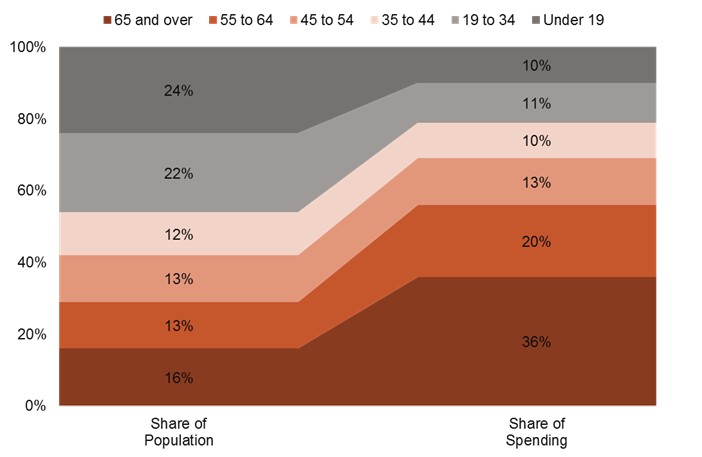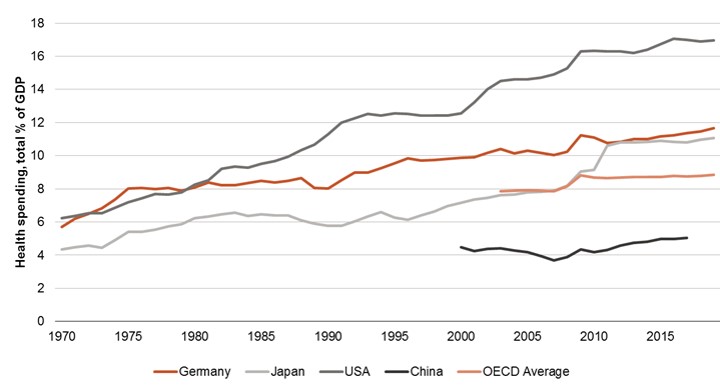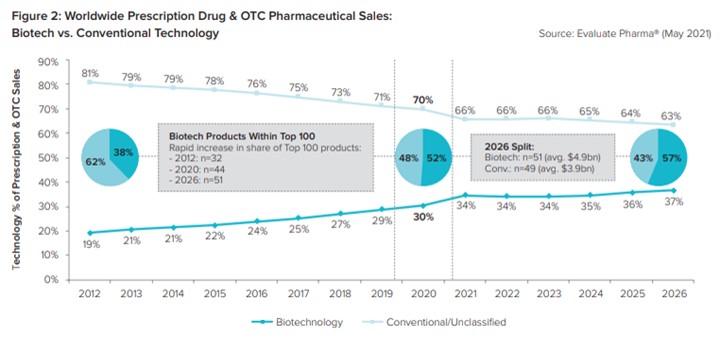Wealth Strategies
Ageing Populations Aren't Sure Bet For Healthcare Investors

Too much focus on the ageing theme disregards stronger and even more powerful structural trends from which healthcare investors can benefit, the author of this article argues.
Last week saw a controversial move by the UK government, led
by prime minister Boris Johnson, to push up National Insurance
contributions (for the benefit of non-UK readers, NI is, a form
of payroll tax) to help pay for the National Health Service and
residential care. Regardless of whether this was smart public
finance or politics (we can leave those debates for others), the
affair certainly reminds us of how an ageing population and
rising expectations of medical care are big policy headaches.
Whether the funding comes from taxation or private contributions
in a free market, these forces will be a major part of investment
and business in coming years. There are investment opportunities
to be had. And wealth management clients need to be on their
game.
To discuss these issues is Kay Eichhorn-Schott, portfolio manager
at
Berenberg Wealth and Asset Management. He points out
that the trend of an ageing population is not a sure route to
improved healthcare investment outcomes. This is also a global
concern, and important in countries such as the US, which has
large private sectors.
The editors are pleased to share these views on this very
important topic, and invite responses. The usual disclaimers
apply to views of outside contributors. Jump into the
conversation. Email tom.burroughes@wealthbriefing.com
and jackie.bennion@clearviewpublishing.com
Many members of the investment industry have long argued that the
ageing of Western societies is providing a strong secular
tailwind for healthcare companies. This is an important insight
but the ageing trend alone is not enough to ensure success for
investors in healthcare. Many healthcare companies face an uphill
battle to turn a profit, while others come with binary risk
profiles; one poorly performing drug and they are in the red.
Demographics won’t necessarily save them.
However, a glance at the statistics might suggest that those
betting everything on ageing have it right. According to the
United Nations, in 2020, 9 per cent of the world’s population was
65 and older with the percentage rising to 16 per cent by 2025
and 23 per cent by 2100. We all realise that the elderly consume
more healthcare dollars than the young. A statistic from the
Kaiser Family Foundation illustrates this well: people over 65
represent only 16 per cent of the US population but account for
36 per cent of healthcare spending (see Figure 1). As societies
age, so, the argument goes, healthcare spending is set to balloon
and healthcare investors will benefit.
There is a big problem with this argument. It rests on the
assumption that expenditure per capita will stay constant. Yet it
is unwise to rely on this assumption.
Figure 1: People aged 55+ account for more than 50 per cent of
healthcare spending in the US

Source: Kaiser Family Foundation
When considering today’s global healthcare expenditure (see Figure 2), a continuation of higher and higher health spending simply does not seem sustainable. In the world’s largest healthcare market, the US, already 17 per cent of GDP is spent on healthcare, a number that the country cannot afford to increase much further. In fact, we expect that the US will need to find ways of reducing healthcare spending per capita. This could be through price erosion or simply by finding more efficient ways of delivering the same quality of care. Betting on a continuation of higher healthcare spending driven by ageing doesn’t take this into account. Ageing alone will not drive abnormal growth for many companies.
Figure 2: Healthcare spending is on the rise

Source: OECD, 1970 - 2019
Rather than investing broadly in the ageing trend investors need
to find companies benefiting from more specific and stronger
tailwinds. One of these trends is the rise of biologic drugs. In
contrast to traditional drugs, biologics consist of larger and
more complex molecules, which also require different production
processes. In recent years, we have already seen a strong shift
towards these new drugs as they are more targeted and for that
reason also more effective. Monoclonal antibodies are the largest
group of biologic drugs; however, there are also new biologic
drugs on the rise, such as antibody drug conjugates (ADCs),
bi-specific antibodies or cell and gene therapies.
Interestingly, much of the innovation in biologic drugs happens
at smaller companies like biotechs rather than big pharmaceutical
companies, as illustrated in Figure 3. The advent of COVID-19
vaccines based on the messenger RNA (mRNA) technology serves as a
great example of this phenomenon. It was not the large
pharmaceutical companies that came up with these life-saving
treatments, but previously small and relatively unknown biotech
companies like BioNTech and Moderna.
Figure 3: Biologic drugs are on the rise

Source: Evaluate Pharma
Investing in pharmaceutical innovators can be tricky. We have
never been huge fans of large pharmaceutical companies. While
their revenues are mostly well diversified across many products,
they typically face an uphill battle: new products need to
compensate (and sometimes overcompensate) for the weakness of
older products due to stronger competition or patent expiry. This
often leads to relatively low growth for these large
pharmaceutical companies.
Investing in small biotechs presents a completely different
challenge. Often, such companies have limited revenues today and
are loss-making. What’s more, their success may depend on one or
a few pipeline products, so the range of outcomes from complete
failure to huge success is wide. If investors do not have strong
convictions in the pipeline, they should stay away. To still
benefit from the overall rise in new drugs from smaller players,
without exposure to this very binary risk, we prefer investing in
companies supplying the drug developers.
Figuratively speaking, in the biologics gold rush, we prefer
investing in the shovels rather than the gold miners. One such
shovel is Lonza, a contract development and manufacturing
organisation (CDMOs).
The company is a specialised manufacturer of pharmaceutical
ingredients and end-products for pharmaceutical and biotech
customers. Lonza benefits from the strong demand for biologic
drugs and an increased appetite for outsourcing manufacturing.
Pharmaceuticals are increasingly relying on CDMOs to manage their
manufacturing capacity more flexibly. In addition, as drugs
become increasingly complicated, CDMOs can offer expertise that
their customers do not have.
CDMOs such as Lonza typically have a large number of customers
and are not dependent on any one drug’s failure or success. For
example, Lonza has formed a multi-year partnership with Moderna
that extends beyond COVID-19 vaccines and entails developing and
manufacturing vaccines against flu. Historically, the vaccine
market has been an oligopoly between many large incumbents that
largely produce their vaccines in-house. With the rise of mRNA
vaccines, newer players will probably enter the market and rely
more strongly on CDMOs such as Lonza for production.
The outsourcing trend in the pharmaceutical industry goes even
further: not only is manufacturing increasingly undertaken
externally but the innovation and drug discovery process is
outsourced too. The reasoning is straightforward. Due to higher
regulatory standards and treatment targets becoming more complex
the development costs for drugs have risen considerably. At the
same time, the potential payoff has shrunk as drugs become
narrower in their application and more targeted in their patient
population. Deloitte estimates that the average development cost
per pipeline project increased by 84 per cent to $2.4 billion
between 2013 and 2020. Yet, during the same time, average peak
sales per asset decreased by around 19 per cent to 421 million.
Unsurprisingly, returns on R&D expenditure have seen a steady
decline.*
To fight this, pharma and biotech companies are increasingly
partnering with clinical research organisations (CROs), such as
the German company Evotec, to identify drug targets, develop
molecules and also manufacture the final product. Evotec has
developed a model in which the company also invests in a number
of pipeline projects where it partners with pharmaceutical
companies, such as Bayer or Bristol-Myers Squibb for further
development. The model has been successful to date and the entire
industry is experiencing strong demand for these collaborations
between large pharma partners and small innovators.
In conclusion, investing based on the ageing theme alone is risky
because healthcare spending per capita, especially in the markets
like the US, could easily start to decline. Too much focus on the
ageing theme also disregards stronger and even more powerful
structural trends from which healthcare investors can benefit.
The rise of biologic drugs and the increasing use of outsourcing
are two examples. The healthcare investment universe does present
long-term oriented investors with a large opportunity set of
innovative companies with strong growth prospects and sustainable
competitive advantages but they have to know where to look.
Reference
*Deloitte 2021, Seeds of Change, Measuring the return from the Pharmaceutical Innovation